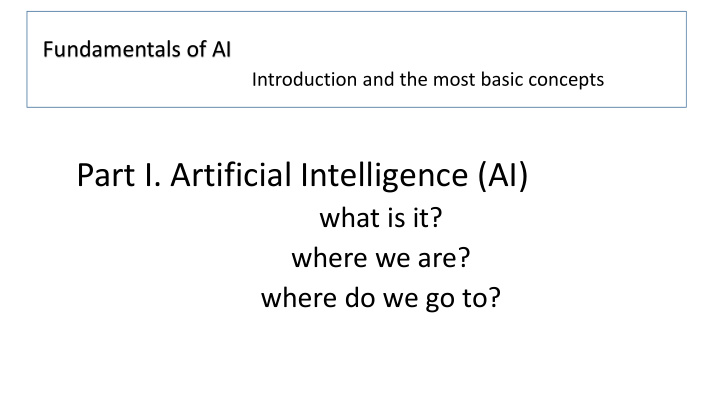



Fundamentals of AI Introduction and the most basic concepts Part I. Artificial Intelligence (AI) what is it? where we are? where do we go to?
Many definitions of AI • Artificial intelligence is a long-term dream of humanity to create ‘thinking machine’ • As a scientific discipline is founded in 1950s, the term coined at the Dartmouth AI conference by John McCarthy • Huge ups and downs in the expectations (e.g., read about the dispute between Rosenblatt and Minsky)
4
This course BIG Data mining
Marvin Minsky’s Problems for AI “It is convenient to divide the problems into five main areas: • Search, • Pattern-Recognition, • Learning, • Planning, Marvin Minsky, Semantic Scholar • and Induction… . courtesy MIT Museum, • Minsky's problems focused research on the most important technical issues. • We are currently seeing great success in these areas. Minsky, M. (1961). Steps toward artificial intelligence. Proceedings of the IRE , 49 (1), 8-30. 6
AI in medicine, genomics and omics (from Rajewsky et al, 2020, Nature)
Single cell omics: how biology becomes a field of data science Biological (physical) view Single cell omics view
Role of Big ig Data + Big ig Models + Big ig Compute in successful AI applications • 21 st century is the century of complexity (Stephen Hawking) • Large number of observations cover more degrees of freedom of complex systems: • Data requirement grows exponentially with dimensionality! • Using big data we can determine parameters of more complex and larger models which better capture the complexity or real-life phenomena (this is a hypothesis) • Big models can go beyond simple human intuition
AI Spring?
https://www.gartner.com/smarterwithgartner/top-trends-on- the-gartner-hype-cycle-for-artificial-intelligence-2019
AI ‘winters’: 1974– 1980, , 1987 –1993, mid 2000s… 12
The term ‘Artificial Intelligence’ coined at the 1956 Dartmouth conference • Many researchers in AI in the mid 2000s deliberately called their work by other names, such as informatics , machine learning , analytics , knowledge-based systems , business rules management , cognitive systems , intelligent systems , intelligent agents or computational intelligence , to indicate that their work emphasizes particular tools or is directed at a particular sub-problem. Although this may be partly because they consider their field to be fundamentally different from AI, it is also true that the new names help to procure funding by avoiding the stigma of false promises attached to the name "artificial intelligence"
Two majo jor current AI I problems 1. AI makes unexpected mistakes , and will make them in the future 2. Decisions of Neural AI are not transparent and, therefore, cannot be explained logically. 14
A Tesla electric car crashed into a highway barrier in Mountain View, California, on March 23, 2018. Investigators confirmed that Autopilot was partially to blame. 15
16
A new AI I win inter wil ill come if if we don't focus on the problem of f AI I errors and AI I explainability And only those applications will survive where errors are not very dangerous 17
Three major flavor of machine learning • Supervised learning • classification, regression • Unsupervised learning • clustering, dimensionality reduction, manifold learning • Reinforcement learning Active learning, Transfer learning, Representation learning, etc. Real practice is almost always a hybrid approach
Recommend
More recommend